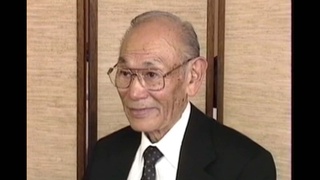Interviews
Treatment of Japanese Paraguayans during World War II (Spanish)
(Spanish) Initially, in 1903, the Paraguayan government passed a law barring black and yellow immigrants from entering. But over the years the law was abolished. In 1919, relations were first established between Paraguay and Japan. But immigrants didn’t start arriving until 1936. Of course, when the war broke out, Paraguay naturally had to take the side of the United States, and so it came out and declared war as well.
But, the important thing is that the Paraguayan government always respected the agreement they signed in 1919, which said that there would always be peaceful and friendly relations between the two countries. They always respected that, all the way up until today. There weren’t humiliations, there wasn’t concentration, concentration camps; there weren’t deportations, you know, none of those things. The only thing of course was that to adhere to the American cause, they closed schools, for example, and some diplomatic authorities returned to Japan. And that’s it, the rest was left alone. With no problems. So that’s why, with that kind of respect, I feel we were lucky, or, you know, the government did respect us.
Date: October 7, 2005
Location: California, US
Interviewer: Ann Kaneko
Contributed by: Watase Media Arts Center, Japanese American National Museum
Explore More Videos

Neighbor took care of hotel business during the World War II
(1918-2023) Nisei Japanese kabuki dancer

Family background of Fredrick Yoshihide Sasaki
(b. 1918) Issei businessman in Canada

Anti-Japanese sentiment at the time of World War II
(b. 1918) Issei businessman in Canada


Four sisters had international marriages (Japanese)
(b. 1937) A war bride from Yokohama

The reason to stay in Japan after his third year
Japanese American Creative designer living in Japan

Lack of political power led to camps
(1924-2018) Researcher, Activist

Choice to move east or go to Japan
(b.1920) Japanese Canadian Nisei. Established the Ikenobo Ikebana Society of Toronto


Institutionalization as a bad aspect of camp
(1924-2018) Researcher, Activist

State Department records show concern for treatment of Japanese American internees
(1924-2018) Researcher, Activist

Remembering December 7, 1941
(1923-2011) Lawyer, MIS veteran, founder of Francis and Sarah Sogi Foundation

Meeting Japanese Americans from the mainland in MIS
(1923-2011) Lawyer, MIS veteran, founder of Francis and Sarah Sogi Foundation

Awareness of concentration camps as a Japanese American
(1923-2011) Lawyer, MIS veteran, founder of Francis and Sarah Sogi Foundation

Manhunt
(1919 - 2005) Challenged the constitutionality of Executive Order 9066.
